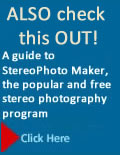|
Twin-lens 3D Cameras

The Rollie Powerflex 3D camera captures 5 megapixel images.

The twin-lens Sony Bloggie 3D captures Full HD (1920×1080) MP4 video and 5-megapixel still photos in 2D or 3D using two image sensors, a stereo microphone and built-in LED light. The Bloggie 3D has an autostereoscopic screen to preview the 3D content you've captured.

Mobile devices have small 3D camera modules built in. Courtesy of Sharp.

The Nintendo 3DS has two lenses on the back of the camera for stereo photography. The captured images and movies can be displayed in 3D on the device's autostereoscopic screen.
The first widely distributed digital twin-lens 3D camera was the W1 from Fuji—soon followed by a number of other twinlens models. These cameras make 3D photography as easy as any other kind—just point and shoot. They all use two lenses separated by the average distance between your eyes (more or less depending on the size of the devices) to capture a pair of images. Since both images are taken instantaneously you can capture action shots. Being point and shoots, these cameras can automatically set the exposure (aperture and shutter speed), focus, white balance, and shutter release for each lens. It's as if two cameras have been blended into a single camera body. Since they capture images instantaneously, they can also capture movies.

The Fuji W3 has two lenses and two image sensors to capture 10 megapixel left and right views of a subject. The autostereoscopic monitor displays the images in 3D.

The Aiptex i2 is primarily a 3D camcorder, capturing 720p video (1280 x 720 pixels) in 3D and playing it back on its parallax barrier 3D monitor. It also captures 5 megapixel still images in 3D and can also capture video and still photos in standard 2D.

The DXG-5D7V pocket camcorder has a 3.2-inch 3D TFT LCD autostereoscopic screen and 4x digital zoom. It can capture 3D H.264 AVI clips and 5-megapixel stills, and then there's always the usual 2D option available as well. To display 3D stills and movies you can connect the recorder
to a 3D display source via HDMI, USB and AV cables.

The Minuro 3D Webcam sends 800 x 600 anaglyph videos that viewers can see in 3D when wearing red-blue glasses.
HD
Most of these cameras can capture movies in high definition (HD) 3D. There are two resolutions of HD—1080 x 1920 called 1080 or Full HD and 720 x 1280 called 720
HD. Sometimes the number is followed by the letter i (for interlaced) or p (for progressive).
One of the fastest growing categories of twin-lens 3D cameras includes those integrated into mobile devices such as handheld games, tablets and smartphones. A big part of the reason these devices are becoming so popular is that adding a single viewer autostereoscopic monitor doesn't add much to their cost. Their 3D capabilities can then be used not just to show 3D stills and movies and play games but also to improve the user interface. Since it will eventually cost so little to add 3D to these devices, and it adds so much to the user experience, it's not hard to imagine a day when they will be taken for granted.

The LG Optimus 3D smart phone features a 4.3-inch WVGA autostereoscopic display for watching 3D movies, playing 3D video games and recording and sharing 3D still images and videos. It has two lenses linked to two 5 megapixel sensors so you can create your own 3D content and seamlessly share it with others through YouTube in 3D with the press of a button.
THE BASELINE
As you will see later in this chapter, the distance between the lenses when capturing a stereo pair has a big influence on the results. Generally a distance shorter than that between your eyes is best for close-ups and a distance greater is best for distant landscapes. The cameras shown in this section have distances that are much narrower to slightly greater than the distance between theaverage user's eyes.
|

